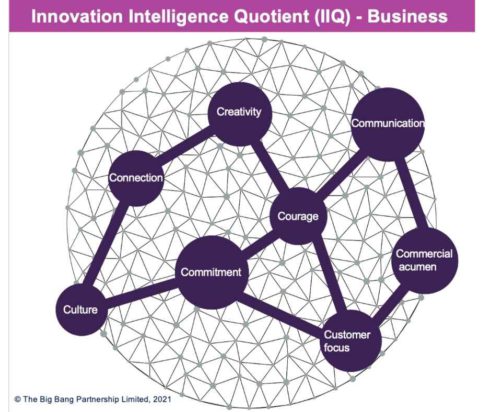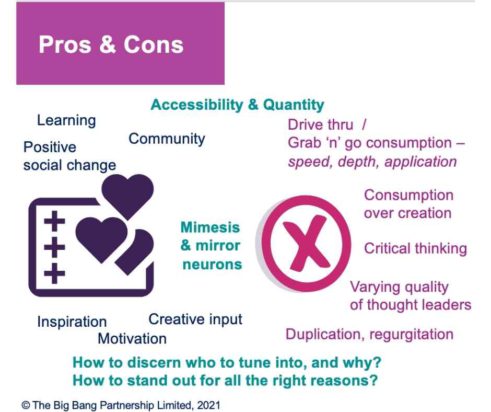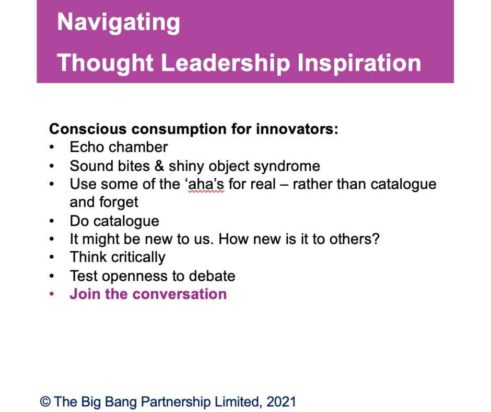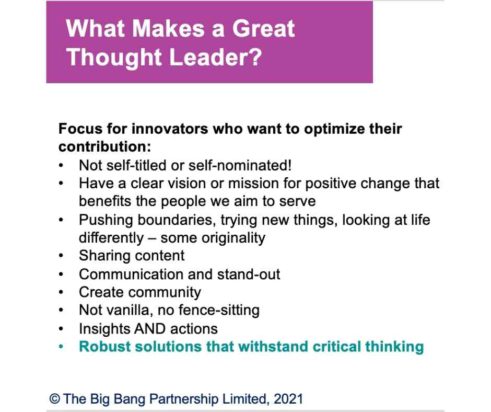Posted in Blog, Create, Innovation, Lead by Jo North
I’ve been delving into the theme of thought leadership for innovators, thinking about when thought leadership is a positive influence, and when it’s not, and reflecting on what we can learn from it as innovators.
Why thought leadership is a useful topic for innovators
Thought leadership is a valuable topic for innovators to explore. It’s useful to examine thought leadership in terms of how we use content from others to inspire our own innovation, and how we can use thought leadership principles ourselves to make a greater positive impact with our innovations.
As innovators, we are committed to making a great contribution and positive difference. We are also people who are learning from what’s going on in the world around us, tuning in to trends, change and new ideas.
Those of you who know me, in person, via my blog, LinkedIn, Idea Time podcast or YouTube content, will know that I’ve always been on a mission to get people innovating, tapping into their creativity and having the confidence to make their ideas come alive.

My innovation mission
Wouldn’t it be fantastic if everyone in business felt inspired, and confident enough to really go for their ideas?
Wouldn’t it be fantastic if we all tuned into ourselves, listening to our own intuition as well as taking on other people’s ideas? And, at the same time, stepping back and critically, evaluating what’s useful, what’s not, and then just going for it and making great stuff happen?
Helping leaders and teams to innovate in this way really energizes me, and I think thought leadership can help in a number of ways.
Thought leadership – ‘How Might We…? questions for innovators
So, in this article, I share my ideas on what we might learn as innovators from thought leadership, answering these two key questions:
- How might we access the highest potential input from everything that’s out there? Because if we have great stimulus, we are more likely to have better ideas and better innovations.
- How might we optimize the contribution that our innovations make?
Because we’re innovating, by definition, we’re doing or creating new things. And hopefully we’re contributing value through that doing or creating those new things.
We can learn from the thought leadership model to do an even better job of communicating our innovations.
A perspective on thought leadership
I’ve studied innovation, as well as worked hands-on to lead innovation strategies for real in many sectors in transport in retail, financial services, public sector, the energy sector, utilities, and all sorts of environments. Successful innovation comes down to the people in the organization working together, communicating, having creativity, courage, commercial acumen, customer focus, commitment, connection, the right culture.
Somebody asked me years ago which thought leaders I follow and why. Surprisingly, at the time I felt really uncomfortable with the question.
I reflected on what was triggering this feeling of unease. I think when we feel uncomfortable about something, it’s often useful to explore why, as there’s learning and growth potential in it.
For me, it came down to the concept or idea that our thoughts are unique to us. Whilst we might have similar thoughts to others, our thoughts understandably feel very personal to us.
Also, why would somebody else’s thoughts be better than mine (or anyone else’s)? Why should we follow somebody else? What’s wrong with our own thinking? (Now, I do appreciate that when people are experts, their thoughts are more useful than mine in their area of expertise, of course).
Our thoughts are personal to us – and precious
Research carried out as recently as 2020, published in Nature Communications, a super well-respected journal, found that we have on average around 6000 thoughts in a single day. The researchers, Poppenk and Tseng, identified these thoughts through brain activity patterns that they called ‘thought worms’, which I just think is an awesome term! They could see when a thought starts and finishes by the little burst of electrical activity that a thought generates.
Some people have quoted that we have 60-80,000 thoughts a day, using different methodologies. But even taking the lower-case scenario, that we have 6000 thoughts per person per day, it’s a lot, isn’t it?
We filter some of them out, parking and accessing them when they’re more useful. But our brains are unique to us, leading me to question whether “idea sharing” is a better description than “thought leadership.” It sounds a much more generous and, to be honest, less sort of conceited way of describing it.
Plus, freedom of thought is a fundamental human right, in my view. I’m always inspired by Viktor Frankl:
“The last of the human freedoms: to choose one’s attitude in any given set of circumstances, to choose one’s own way.
Viktor E. Frankl, Man’s Search for Ultimate Meaning
Definition of thought leadership
But, when I started to dive into definitions of what a thought leader knows, does and is all about, I found this definition:
“Thought leaders are the informed opinion leaders and the go-to people in their field of expertise.
They become the trusted sources who move and inspire people with innovative ideas; turn ideas into reality and know and show how to replicate their success.
Over time, they create a dedicated group of friends, fans and followers to help them replicate and scale their ideas into sustainable change not just in one company but in an industry, niche or across an entire ecosystem.”
Denise Brosseau, Thought Leadership Lab
I think it’s an excellent definition. Thought leaders are informed opinion leaders and go-to people in their field of expertise. They are the trusted sources who move and inspire people with innovative ideas. Thought leaders have had success. They know how to replicate that success and they share their knowledge with other people. And thought leaders generate energy amongst a group of people dedicated to supporting that way of doing things to drive a really big change across an entire ecosystem.
Benefits and challenges of thought leadership
When used skillfully and responsibly, thought leadership can make a brilliant impact for positive change in a team, organization or community. As long as the thought leader in question is credible, knows their stuff, is coming from a good place, is well-informed, and trustworthy, as well as trusted.
Positive thought leadership has the potential to do so much good for, for society, for organizations, for the business community, and the customers that we serve.
It’s also an opportunity because there is so much out there, and it’s easily accessible. We can access all these thought leaders online, through video, books, social, blogs and more.
The challenge is working out which ones are the great thought leaders that are going to help us and take us to where we want to go.

Competing for attention amongst all the noise
How do we stand out with our innovations and the difference we are trying to make with our innovation mission when there is so much information available, competing for attention?
You won’t be surprised that Statista cites that in 2021, 4.6 billion people are actively using the internet. This is just short of 60% of the global population. The vast majority, again over 4 billion people, are using mobiles to access the internet and social media.
On the positive side, this creates the opportunity for learning, community building and connection. We can find people with similar interests or different points of view from all over the world and learn from each other.
There’s the opportunity to drive positive social change, and we can get inspired and motivated by what other people have achieved. All of this creates some brilliant creative input for innovators.
Creation over consumption
However, I think we’ve also grown a drive-by, grab and go information consumption culture. We whizz past great thinking. We pick it up and then drop it as we go. We’re all too often not getting into the depth that would really serve us.
And I question how well we’re applying all the things that we are choosing to engage with from a thought leadership perspective. We might see something great, that might inspire us. It might trigger a brilliant thought, but what are we doing with that? Are we going any deeper? Are we really using those insights?
Whilst there are exceptions, overall we seem to prioritize consumption over creation. There’s so much content available that it’s easy to consume, and then regurgitate, instead of making the effort to develop some original thought that builds on the idea, or that takes the thought in a different direction.
Critically evaluate your thought leaders’ content
I often wonder how well we’re doing critical evaluation of the information we consume. Are we accepting people and what they say they can do at face value, because of an image that’s in the media or in social? Or are we actually evaluating the quality and the credibility of what they’re proposing and what’s being said?
There is such a huge variance in the quality of thought leaders. We need to be discerning to work out who to tune into as innovators, and why, and how we ourselves can stand out for all the right reasons and be a great quality thought leader too.
What matters with thought leadership is how we use it and what we do with it. It’s about us taking responsibility, I think, to contribute authentically and wisely, and to choose the people and ideas we follow with discernment.
Contemporary thought leadership examples
So back to the question. I was asked which thought leaders do I follow and why? And it was a hard one to answer, but here are my top three: Andrew Huberman, David Bowie and Oprah Winfrey.
Andrew Huberman is professor of ophthalmology and neurobiology at Stanford University. He’s on the cutting edge of everything to do with, with neuroscience around performance and well-being. Huberman has free podcasts and a great YouTube channel. His mission is to put into the public domain for free the latest information that’s coming out of neuroscience so that we can all perform better and live healthier, more fulfilled lives.
I’m a big Bowie fan. I don’t think that everything Bowie did was cool, but from a music and a creativity perspective I respect him as a thought leader. He was someone who was not afraid to go out there, create differently and really stand out. As a thought leader he left a great legacy too, as his art lives on after his death.
Oprah Winfrey is an awesome businesswoman and thinker. She’s doing some amazing work in education and learning.
Examples of business and brand thought leadership
Of course, thought leadership isn’t limited to individuals. Businesses and brands can be thought leaders, too. Here are some examples.
Google’s mission is to organise all the world’s information and make it universally accessible, and they they’re doing a pretty good job of that, I think, in many ways.
Patagonia stands strong on the principles of circular economy and the environment. These are rigorously baked into Patagonia’s value proposition and business model.
Circos is an example of a smaller organisation that is a thought leader. The company puts baby and toddler clothes into recirculation, so that the clothes can be used several times because babies grow out of things quickly and don’t wear their clothes out. Circos takes baby clothes back, makes them pristine again, and then recirculates them, which I think is a distinctive and creative business model.
Everyday thought leadership
And it’s not just big names. Thought leaders can be individuals in your team, organization, community, industry, sector, town, city, region, village club, adding value, influencing and contributing to positive change, for example, working with youth, leading the way to support a charity, helping others out, campaigning for a better local environment.
6 tips to navigate thought leadership content for innovators
How do we navigate all this potential thought leadership content as innovators? What how do we take responsibility and be more selective? Here are some tips.
- Be a conscious consumer and be mindful about the content we focus on.
- Get out of the echo chamber. When we’re on social media, what we’re often presented with, thanks to the algorithm, is content that we are already into or that reflects our views. But sometimes it’s good to look beyond that and explore new areas. When we only listen to people with the same views as our own our thinking doesn’t stretch. Our brain stays in a comfortable place. Instead, actively expose yourself to diverse points of view.
- Go beyond the sound bites, personal image and following of any thought leader. Use your critical evaluation and judgement to question and assess the real value of their contribution. Don’t go chasing after what seems to be the shiniest, most interesting thing in the moment.
- Commit to act on the thought leadership content you discover that sparks an idea or a solution. Don’t just store it and move on.
- Keep a journal with all the great ideas that you discover, exactly from whom and where you found them so that you can revisit them later.
- Test the openness to debate of any thought leader that you’re interested in. I find that the people who have the most to offer will engage when you debate respectfully, constructively and professionally, in all the right ways with the right behaviors. The thought leaders who are really committed and genuine don’t deny anybody else’s opinion or point of view. They are open to discussion and actually really enjoy that exploration. Join in the discussion. Don’t be a lurker. If you’ve got a thought or question, contribute to the conversation, help it to get richer and more productive.

7 tips on becoming a thought leader for innovators
What can we learn from thought leaders to help us share our innovations and influence for good?
- In my view, ‘thought leader’ isn’t a title we should give ourselves. It’s not a self-appointed, self-nominated position or title. It’s one that others, I think, need to say about us, rather than us saying it about ourselves.
- Great thought leaders have a mission and a vision for positive change that benefits the people they want to serve. Their intention is to make a positive difference, not just help themselves.
- Thought leaders push boundaries. They try new things and look at life differently, with some originality.
- Sharing content generously, communication excellence and standing out are all essential for true thought leadership.
- Thought leaders aren’t in it to be popular or just vanilla. They have a point of view, and they speak out, often with courage.
- Some of the most inspirational thought leaders create community. A stimulating and motivational space where people can share ideas, learning, and have conversations really that take the thinking forward.
- A thought leaders actions need to match their message. They walk the talk.

Next steps
I hope my article has been useful in helping you to think about your own position with regard to thought leadership, both how you approach content from others and how you use your innovation thinking to connect with your community, whoever your community might be.
I’d love to read your thoughts, questions and comments, so please let me know what you think, either here on the blog or on my social channels.
You can also access loads of free innovation resources from my Content Studio here.

